
Birds
Robins
DUSKY ROBIN
Melanodryas vittata

Like all robins I've encountered, this is a charming little bird. Unlike the other Tasmanian robins, both sexes look alike but young ones have streaking on the belly and upper wings. The easiest way to tell the difference between this robin and female scarlet and flame robins is the dark stripe running through the eye and an absence of a pale or white forehead band.
Dusky robins often perch on a rock or stump, from which they pounce on prey on the ground. They are sometimes called sad robins, as their song can sound quite wistful. They also have a range of other names - Dozey, Sleepy, Stump, Tasmania/Wood Robin, and Native Sparrow. The bird is listed as vulnerable on some sites due to its declining numbers.
FLAME ROBIN
Petroica phoenicia

F
F
Photo (inset): David Cook, Canberra Birds
Female robins can be difficult to identify as they have subdued colouring and most photos of flame, scarlet and pink robins are of the males, which are more colourful. For this reason, the photos on this site focus on the females.
Flame robins can be confused with scarlet robins. Flame robins tend to have smaller white/pale forehead patches than scarlet robins. The male's red breast tends to have a more orange hue than the scarlet robin's, the colouring extending further up the throat. The bird's behaviour has been described as "nervous and twitchy, flicking its wings alternately when still". It is an insect eater, eating small prey whole but smashing the heads of larger prey before eating. iNaturalist has a very comprehensive website on this bird.
PINK ROBIN
Petroica rodinogaster

F
M
Photo: Paul van Giersbergen
Inset: Tobias Hayashi, Canberra Birds
Photos of female pink robins are almost as rare as hen's teeth so a round of applause to Paul van Giersbergen for this gorgeous photo of a lovely little lady. She looks nothing like her male counterpart, which is unmistakeable with its dark grey/blue - almost black - head and back and a vivid pink breast. The female has a couple of orangy-buff bars on her wing, which are a useful way to tell her apart from other robins.
I have seen pink robins in Knocklofty but not often - apparently they prefer wetter environments than the other robins. They are also harder to spot. Quieter than the other robins, they spend a lot of time in dense shrubby undergrowth. Pink robin nests are bound with spider webs, and lined with fine soft grass, fern or fur.
SCARLET ROBIN
Petroica boodang

F
M
The Scarlet Robin is quite common on Knocklofty and is fairly tame and easily approached. Like the Pink Robin, the Scarlet Robin has strong sexual dimorphism - i.e. the sexes are quite different - and most photos show the male.
Scarlet robins eat insects and generally pounce on them from or near the ground but in summer they tend to change this behaviour, shifting to "snatching and hawking" in tree canopies (SA Gov Env & Heritage). In autumn and winter, they join
mixed flocks of other small insectivorous birds. These mixed flocks are very evident on Knocklofty, patches of varied birdsong and rapid movement amongst larger, quieter areas.
Columbiformes (pigeons and doves)
= Seen by me on Knocklofty
= Photo taken at Knocklofty
BRUSH BRONZEWING
Phaps elegans
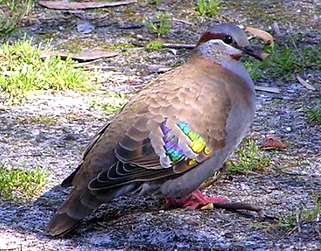
Photo: Harvey Perkins, Canberra Birds
One of my favourite birds of Knocklofty, the brush bronzewing is a very attractive bird with beautiful iridescent coloured bars on its wings. These birds spend a lot of time on the ground, alone or in pairs, where they find seeds and grains. Like many grain eating birds, they will eat small pieces of grit and pebble to help grind seeds within the gizzard. They drink at dawn and dusk, approaching water sources carefully and from a distance. They are quite timid and will take off with a noisy clapping of wings before you have even spotted them.
There are some excellent photos at this site: Brush Bronzewing (Phaps elegans) (mdahlem.net). You can also hear the bird's metronomic coo amongst all the other bird chatter.
COMMON BRONZEWING
Phaps chalcoptera

M
The common bronzewing is found in a wide variety of habitats in all states of Australia. It has a strong resemblance to the brush bronzewing, but more delicate colouring, especially the female. It also has a regular call like a metronome and can be seen calling high in the canopy when it's not walking around on the ground pecking at seeds. Like other pigeons, it claps its wings on take off.
Bronzewings, like other pigeons, secrete a special milk-like substance from their crop (a pouch where food is stored before digestion), which is fed to the young chicks. They need to drink often so can be found near water.
SPOTTED TURTLE DOVE
Spilopelia chinensis

As the name "sinensis" suggests, this bird originates from China. It was introduced in Melbourne in the 1860s and is now very successful around Australia. I've seen more of these in suburban gardens than on Knocklofty.
Birdlife Australia notes that the spotted dove builds its nest from a few fine twigs which is so frail that the eggs can often be seen from below, and they often fall out. In spite of this, the species has done well,
spreading all around Australia. Like all pigeons and doves, it is largely vegetarian, eating seeds and grains mainly.
Artamids and corvids
AUSTRALIAN MAGPIE
Gymnorhina tibicen

Although I was attacked by a magpie doing cross country at school in New Zealand, I am quite fond of magpies. They are a great songbird and mimic, and can be very playful and friendly with humans, They can live for 25-30 years - long enough to learn a few tricks. They are omnivores, eating a wide range of foods and, on the mainland, have learned to eat cane toads by flipping them upside down and eating the underparts.
The magpie can mimic the calls of over 35 species of native and introduced birds. They can also impersonate dogs, horses and, when living near people, humans. Unlike magpies on the mainland, Tasmanian magpies don't swoop on people even though they are the same species.
BLACK CURRAWONG
Strepera fuluginosa
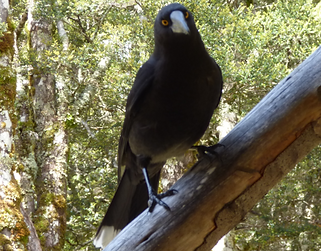
Often found in alpine regions, the call of the black currawong is highly evocative of these locations. They can be very tame if food is involved, One came into the back of our van uninvited at Mt Field and walked around looking for tidbits. The above photo was taken at Cradle Mountain National Park.
According to the Australian Museum, the black currawong was widely eaten in the early days of European settlement in Tasmania and said to be quite tasty.
GREY CURRAWONG
Strepera versicolor

The grey currawong is also known as the clinking currawong because its call sounds like "clink clank" (although I think it's more like "crick crick"). As well as having a plainer song than black currawongs, grey currawongs have straighter bills and white feathers under their tails. Both species have fabulous yellow eyes.
The grey currawong measures around 50cm in length, and has a wingspan of around 80cm. It can often be seen on the ground, where it hops or runs while foraging. It eats a wide range of foods including invertebrates, such as snails, spiders and woodlice, all kinds of insects, frogs, lizards, skinks, rats, mice, and nestlings or young birds of several species.
GREY BUTCHERBIRD
Cracticus torquatus

Butcherbirds can often be seen and heard on Knocklofty. Named the butcherbird for their ghoulish habit of impaling prey and leftovers on small branches, these birds are real characters. They are an impressive songbird, singing at length and with enthusiam and variety, and often quite musically (although the song of the European songthrush is much more beautiful). They will sing solo, in duets and in groups. They accompany this with grandiose gestures, creating a real piece of performance.
Adult birds are black, white and grey. Juveniles are more brownish. They have a marked hook at the end of their bills..
DUSKY WOODSWALLOW
Artamus cyanopterus

The smallest in this group of birds, the dusky woodswallow is pretty common on Knocklofty (all the birds in this group are common there except, I think, the magpie).
A key distinguishing behaviour of this bird is its tendency to wag or swivel its tail. I notice this particularly when the bird lands on a branch.
These birds often hang out in groups and may migrate north in autumn.
FOREST RAVEN
Corvus tasmanicus

Very common on Knocklofty, these birds are particularly noticeable in winter when their cynical, mournful and complaining calls of "aaargh" and "bah!" can sometimes be the only bird call heard. They seem to like chilly grey days with low cloud to sit hunched and baleful, muttering their complaints and wry opinions to each other.
Adults have striking white irises while the young have brown irises fading to hazel with a blue rim. The bird is otherwise all black. They will eat insects, grain and carrion. They will defend their territory, chasing and mobbing birds of prey including eagles. They are highly intelligent and adaptable, and add bucketloads of eerie ambience to the bushland reserve.
Honeyeaters
BLACK-HEADED HONEYEATER
Melithreptus affinis

Photo: Paul van Giersbergen
Black-headed honeyeaters are endemic to Tasmania. They have an olive coloured back and a black head. According to Donald Knowler they "often go unnoticed but their song is the background music of the more leafier Hobart suburbs and on the lower slopes of kunanyi/Mt Wellington. It’s a gentle, incessant piping heard from dawn to dusk.
"Out of Tasmania’s four endemic honeyeater species the black-headed honeyeater is generally considered the least interesting and dramatic. It is not showy and flashy like some of the others, and goes about its honeyeater business in industrious fashion. If it wasn’t for the song ringing through the treetops you would never know the bird was there."
CRESCENT HONEYEATER
Phylidonyris pyrrhopterus

Photo: Lindsay Hansch, Canberra Birds
A small but striking looking honeyeater, the male has a dark face mask with a white eyebrow that can make it look quite fierce. The females have gentler colouring. Both sexes have a pale breast with a dark crescent down either side. Eastern spinebills also have striking markings on the breast but are more colourful and have a longer, finer, downward curving bill.
It is a bit of a seasonal migrant, spending more time at higher altitudes in summer, and moving to lower elevations and coastal areas in cooler months.
NEW HOLLAND HONEYEATER
Phylidonyris novaehollandiae

Common around Hobart, these smallish birds (around 18cm long) are very zippy! They zip around, always on the go, and they often make "zip zip" kinds of calls. They are easily identified by their streaky chest, yellow wing bar and white eyes. Although they are predominantly honeyeaters, they will eat insects for protein and I have often heard their bills snapping at insects as they fly. I've seen them have a stoush or three with Little Wattle Birds as they like the same foods.
Their nests are made of bark and grass, bound together with spider webs (how smart!). In winter, the nest is built on a sunny, outer part of the shrub. In summer the nest is made deep in the bush to keep it cool.
STRONG-BILLED HONEYEATER
Melithreptus validirostris

The strong-billed honeyeater could be mistaken for the black-headed honeyeater but it has a white throat with a small black chin stripe and a strong white band running back from its eye. Both species are endemic to Tasmania and can be seen in heathlands and sclerophyll forests all over the island. The two species will often hang out together.
Most of the Tasmanian honeyeaters include some insects in their diet, but the strong-billed honeyeater's diet is mostly insects. It will hop up and down tree trunks ripping noisily at the bark to get them.
YELLOW THROATED HONEYEATER
Nesoptilotis flavicollis

Also endemic to Tasmania, the yellow throated honeyeater can often be seen and heard on Knocklofty. It has a bright olive green back, grey head and underbelly and a vivid yellow chin and throat. I often see them amongst groups of smaller birds, such as thornbills and pardalotes, but Wikipedia says they will aggressively drive these species out of its territory.
They line their nests with hair or fur, including hair from live animals. The female will leave her nestlings to be fed by the male if she is starting a second brood, however the male will drive off the fledglings when they are old enough, and he will eventually drive the female away too.
I don't normally see them on the ground.
The one in the photo above sadly had an injured wing and couldn't fly properly.
NOISY MINER
Manorina melanocephala

This bird is listed on the Friends of Knocklofty website, but I'm not sure if I've ever seen one on Knocklofty. They are common in the domain, at Rosny and Bonorong.
These are funny-looking characters, there is something sad but also comical about the way they look and the way they stand, but actually they are vicious gangsters. Not content with forming large mobs to attack predators, they will also mob and brutally attack small birds like pardalotes that are in their territory. The species is expanding its range of human-dominated habitats, by excluding smaller bird species from urban environments in this way.
LITTLE WATTLEBIRD
Anthochaera chysoptera

The smallest of the wattlebirds, this wattlebird has no wattles. It's a very common bird around Hobart and spends much of its time eating nectar from flowers. It also likes fruit and will shoo New Holland honeyeaters away if they try to share the crop.
The little wattlebird has a much larger repertoire of vocalisations than the yellow wattlebird. Wikipedia says its calls include "a strident cookay-cok, a raucous fetch-the- gun, a mellow guttural yekkop, yekkop and many squeaky, musical lilting notes. The alarm call is a kwock or shnairt!".
YELLOW WATTLEBIRD
Anthochaera paeadoxa

Found only in Tasmania, the Yellow Wattlebird is by far the largest of Tasmania's honeyeaters. A handsome bird, named for the yellow wattles that hang down from its face, it has a very inelegant call, which sounds like "pluck" or "glurk", giving rise to its nickname, the "chuckbird'.
It is mostly a nectar eater and loves overripe fruit. Due to its large size and diet of fruit and nectar, according to Donald Knowler (whose page on yellow wattlebirds is well worth reading) it was "shot for the pot during hard times experienced by the early settlers and Tasmanian workers struggling during the great depression."
EASTERN SPINEBILL
Acanthorhynchus tenuirostris

This striking looking bird is very common on Knocklofty as well as in Hobart gardens. It can be found all along the east coast of the Australian continent. Eastern spinebills rarely stop moving, so they're challenging for the amateur photographer! It took me a lot of failed attempts to get this shot.
The eastern spinebill eats nectar from a wide range of native and exotic flowers. Its long, downward curving bill means it can reach nectar from tubular flowers. It can feed while hovering, similar to a humming-bird. In mid-winter, males aggressively exclude smaller females from areas with lots of nectar, so females tend to die younger.
Cuckoos
FAN-TAILED CUCKOO
Cacomantis flabelliformis

Cuckoos aren't nice birds. They lay an egg in the nest of another bird species, removing one of the host bird's eggs, and leave their own for the nest owner to raise. As their young are often much bigger than the unwitting host parent's own offspring (or even the host parent), this can be hard work for the host with no benefit to the species. The young cuckoo will itself biff out the host's eggs or hatchlings. Like mother like child.
Having got that off my chest, I think this bird is very pretty in an undramatic way, with quite an appealing little song. They like eating hairy caterpillars.
HORSFIELD'S BRONZE CUCKOO
Chryscoccyx basalis

Photo: Julian Robinson, Canberra Birds
Tasmania has two bronze cuckoos. Horsfield's can be distinguished from the shining bronze cuckoo by its white eyebrow and brown eye stripe. Quite a pretty bird, but basically a psychopath.
It generally parasitizes nests of fairy wrens and brown thornbills. It has evolved to lay eggs quite small for its size, making them less conspicuous amongst the smaller host's own clutch. The female cuckoo can lay an egg in under six seconds, lessening its chances of being sprung. The youngster hatches before the host's eggs, and tosses them out of the nest.
PALLID CUCKOO
Cacomantis pallidus

The largest of Tasmania's cuckoos, the pallid cuckoo parasitizes the nests of honeyeaters, woodswallows and robins, Like the fan-tailed cuckoo, it likes hairy caterpillars, which most other birds avoid.
A migratory bird, the pallid cuckoo arrives in Tasmania around September-October and spends the winter months in central inland Australia and the Northern Territory.
It's sometimes called the unadorned cuckoo, semitone-bird, scale-bird or brain-fever bird—from its monotonous repetitive call. Tim Siggs has a nice little video of this bird on you tube (but not calling).
SHINING BRONZE CUCKOO
Chrysococcyx lucidus

Photo: Stuart Harris, Canberra Birds
According to Animalia, this is the world's smallest cuckoo, being only 15 to 17 centimetres long. It has metallic golden or coppery-green upperparts and a barred belly. A migratory bird, it spends summer in Australia and winter in Indonesia and Papua New Guinea.
Shining bronze cuckoos eat caterpillars, moths and beetles. They lay their eggs in the nest of thornbills, fairy wrens and scrub wrens, amongst others.
Pardalotes and thornbills
SPOTTED PARDALOTE
Pardalotus punctatus

M
F
STRIATED PARDALOTE
Pardalotus striatus

BROWN THORNBILL
Acanthiza pusilla
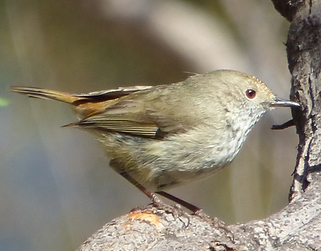
Photo: Geoffrey Dabb, Canberra Birds
Inset: David Cook, Canberra Birds
A gorgeous little jewel box of a bird, at 8-10cm, this is one of Australia's tiniest birds. The spotted pardalote has a typical elegant pardalote bowl-like shape, with a stubby tail and no real neck. Seen from on top, these birds are covered in spots.
They are common in eucalypt woodlands around Australia. They spend a lot of time high in the canopy looking for insects, but often nest in earth banks and I have seen them on the ground on several occasions, and managed to stand very close to one for quite a while (but without my camera!!).
The Striated Pardalote is found only in Australia and is common across the continent and Tasmania, except for the most arid areas. This bird eats a wide variety of insects and their larvae, which it picks from the surfaces of leaves. Feeding takes place in small groups.
Striated pardalotes usually nest in tree hollows or tunnels excavated in an earth bank. Both sexes incubate the eggs and care for the young. Other members of the group may also help with the feeding of the young. I see and hear these birds most often on the summit track looking across McRobie's gully to the mountain.
Birders call these birds "LBJs" (little brown jobs). They are all very small and fast, and are usually hidden behind branches or foliage, so really hard to photograph. I have a good stock of photos of wings, tail feathers and empty branches. (You can see some great photos by other people here.)
Enough of my woes. This bird is extremely common on Knocklofty. It has a raspy kind of chirp but is also an excellent mimic, and may mimic the alarm calls of other birds to scare predators - really clever.
TASMANIAN THORNBILL
Acanthiza ewingii

Photo: Paul van Giersbergen
This little bird (around 10cm long) is endemic to Tasmania and Flinders Island. It looks very simliar to the brown thornbill but has a longer tail, a greyer throat and chest and has white undertail feathers - there is an adage that this bird "wears white underpants".
Its habitat often overlaps with the brown thornbill but the Tasmanian thornbill tends to prefer wetter areas than the brown. Its nest is made of grass, moss, and fine strips of bark, with a hinged flap for an entrance.
YELLOW-RUMPED THORNBILL
Acanthiza chrysorrhoa

Photo: Wikipedia
A pretty little bird with a cheerful chattering call, the yellow rumped thornbill has a white-spotted black crown and, yes, a yellow rump. It feeds mostly on the ground, eating insects and sometimes seeds.
At breeding a pair may be assisted by one or two helpers, which help to build the nest and feed the young. The nest is made of grass and bark and has two parts: a 'fake' nest on top and a lower chamber with a hooded entrance. The purpose of the fake nest is unclear, but may be a way to avoid unwanted cuckoo eggs.
Psittacids
EASTERN ROSELLA
Platycercus eximius

One of our most colourful birds, the eastern rosella can be easily distinguished from the green rosella and rainbow lorikeet by its red head with white cheeks and their yellow-edged black back feathers. This is a sociable, chattering bird that has at least 25 different calls.
Eastern rosellas nest in tree hollows and cavities and will defend an area up to 30m around the nest. Females incubate the eggs alone, but the male brings her food. The pair will stay together for life.
Both Eastern Rosellas and Green Rosellas will cross breed with other rosellas and I believe I have seen a such a pair in Knocklofty on more than one occasion. I have seen them nesting in a tree hollow over the last few days (Nov 2023).
GREEN ROSELLA
Platycercus caledonicus

Only found in Tasmania and the Bass Strait Islands, this is definitely the parrot I see most often on Knocklofty. It's Australia's largest rosella and has quite dark, subdued colouring on its back but a bright yellow body, blue cheeks and a red stripe above its beak. Juveniles are much duller in colouring. Green rosellas can live up to 25 years.
They often hang out with eastern rosellas, and I have seen a mixed group on Knocklofty. Back in the 1800s, these birds were eaten and said to be delicious.
MUSK LORIKEET
Glossopsitta concinna

Musk lorikeets eat mainly pollen and nectar from eucalypts and have specialised brush-tipped tongues to do this with. They will also eat seeds, fruits and insects and their larvae.
They are gregarious birds and are often found amongst groups of other parrots as well as honeyeaters when feeding. They are very communicative, chattering and chirruping with each other while feeding and flying.
SWIFT PARROT
Lathamus discolor

Photo: Stuart Harris, Canberra Birds
A critically endangered species, scientists predict numbers of these birds to fall rapidly due to nest predation by the introduced Sugar Glider in Tasmania. Habitat loss and alteration are also impacting on their numbers.
I'm not aware of having seen the swift parrot on Knocklofty, but it often feeds and flies with lorikeets, which look similar. It has been called "noisy, active and showy, with a very fast, direct flight." It's main food source is nectar from the Tasmanian blue gum and black gum.
The swift parrot migrates here from the mainland each year to breed. Any sightings of this bird should be reported.
SULPHUR CRESTED COCKATOO
Cacatua galerita
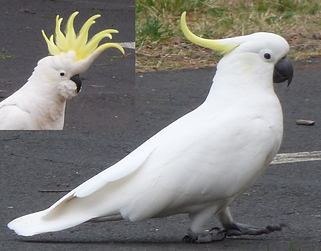
Smart, insouciant and unpleasantly raucous, these birds have attracted attention recently for cleverly figuring out how to open wheelie bin lids to grab the leftover pizza. (I don't think the Tasmanian ones have caught on to this yet. The wind blows our bins over instead.) They appear to have a sense of rhythm and in captivity some have spontaneously danced to music with a variety of unique moves.
These birds live to about 20–40 years in the wild but can live up to 100 years in captivity. They have been known to eat clay to detoxify their food. Sulphur-crested Cockatoos have also been known to mob raptors to drive them away.
YELLOW-TAILED BLACK COCKATOO
Calyptorhynchus funereus

In spite of their name 'funereus', and their largely black colouring these birds have cheery looking expressions. They have yellow cheeks, yellow panels in their tail feathers and yellow edges around the feathers on their body, creating a scalloped look. I have not seen these on Knocklofty myself, although I have seen them close by in twos or threes. I saw a flock of 70-100 at Seven Mile Beach once.
They nest in tree hollows. Wikipedia reports that the same tree may be used for many years. A 1994 study of nesting sites in
eastern Victoria found the average age of trees used for hollows by the yellow-tailed black cockatoo to be 228 years.
Raptors
BROWN GOSHAWK
Accipiter fasciatus

Photo: Julian Robinson, Canberra Birds
Not the cuddliest looking bird, the brown goshawk does have very striking markings, especially when in flight. They have long yellow legs with stripy britches and bright yellow eyes, with low protruding eyebrows.
Found right across Australia, Brown Goshawks feed on small mammals, particularly rabbits, as well as birds, reptiles and insects and sometimes carrion. In urban areas, they often eat sparrows and starlings. They hunt stealthily from a low, concealed perch, using sudden, short bursts of speed to pounce onto prey. They will occasionally stalk or run along the ground after insects.
GREY GOSHAWK
Accipiter novaehollandiae

Photo: Lindsay Hansch, Canberra Birds
The grey goshawk comes in two colour variations, grey and white. Only the white form ("morph") is found in Tasmania, so some people very reasonably call this bird the white goshawk. It's the only pure white raptor in the world. This bird, although found in most states is endangered in Tasmania. I have not seen one on Knocklofty but one occasionally lands on our neighbours' chimney.
Quite a large bird, the female is almost twice as heavy as the male. Grey goshawks eat rabbits, possums, bats, birds, reptiles and insects. They depend on mature forests for breeding, rarely using forest regrowth less than 30 years old.
COLLARED SPARROWHAWK
Accipiter cirrocephalus

Photo: Stuart Harris, Canberra Birds
Most birders familiar with the collared sparrowhawk and the brown goshawk will tell you that they can be hard to tell apart. The collared sparrowhawk is more slightly built, with slender legs, a grey back with a reddy brown collar and it doesn't have the 'baggy pants' of a brown goshawk. The collared sparrowhawk can have a rather vacant, round eyed look, it doesn't have the fierce jutting eyebrows of the brown goshawk. It's said the "collared sparrowhawk stares and the brown goshawk glares".
The female is larger than the male and can last over twice as long without eating (around 8 days compared to 3 days for the male).
BROWN FALCON
Falco berigora

Falcons are charismatic birds, in my opinion. They have striking face markings, intense eyes, a streamlined shape and are excellent flyers. The brown falcon is common around Australia - the bird in the above photo was on the power pole across the road from us.
Brown Falcons feed on small mammals, insects, reptiles and, less often, small birds. They have powerful hooked bills with specialised 'teeth' and matching notches which can sever neck bones with one bite. The brown falcon is sometimes called the chicken hawk or cackling hawk because of its cackling call.
PEREGRINE FALCON
Falco peregrinus
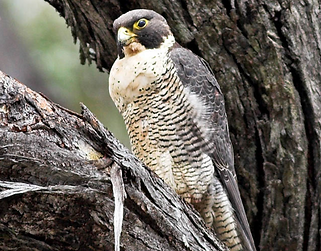
Photo: Julian Robinson, Canberra Birds
Found almost everywhere around the world, except polar regions and New Zealand, this bird is the fastest of all animals on the planet. It can swoop down at speeds in excess of 300km/hr. Peregrines have yellow legs and eye rings and, like the brown falcon, the female is larger than the male. They eat small and medium-sized birds, including rock pigeons, rabbits and other day-active mammals. Peregrines live up to 19 years.
Pairs of falcons may hunt prey co-operatively, with one (usually the male) scattering a flock of birds while the other swoops down to attack a particular individual. Wikipedia has an excellent page on this bird, well worth a read.
TAWNY FROGMOUTH
Podargus strigoides

Tawny frogmouths are masters of camouflage and their main defence method is to remain still and appear as a broken tree branch. They have feathers which enable them to fly silently and stealthily. They have big yellow eyes, but during the day these may be reduced to slits. They also have whiskers around their beaks. The young are strange-looking but cute balls of fluff.
The genus name, Podargus, is from the Greek for gout, as their feet are small, and they’re said to walk as though they have gout. Tawny frogmouths mate for life and can live up to 14 years. They eat small critters, including insects, worms, slugs, snails, frogs and reptiles.
SOUTHERN BOOBOOK/MOREPORK
Ninox leucopsis
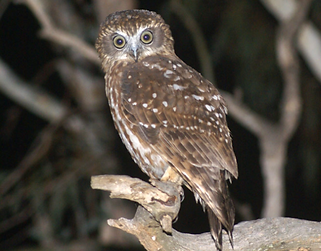
Photo: David Cook, Canberra Birds
'The Southern Boobook was only recognised as a separate species in 2022. Previously it was considered to be the same
species as the New Zealand morepork/
ruru. These names imitate the bird's two syllable call, which is a gentle and comforting sound at night.
The Southern Boobook is the smallest and most common owl in Australia. A heavily streaked and spotted bird with a chocolate brown back, it has large, very round eyes with yellow irises.
This bird eats mice, bats, insects and other small animals. It nests in tree hollows, and feeding of nestlings is carried out by both sexes. Sometimes another female will also help with this task.
Other birds
BEAUTIFUL FIRETAIL
Stagonopleura bella

Photo: Paul van Giersbergen
Also known as the Tasmanian Finch, this bird can be identified by its bright red rump, red bill and pale blue eye ring. I haven't seen this bird on Knocklofty, but the Friends of Knocklofty site says it may be seen there. It likes to live close to water. Beautiful firetails scuttle around on the ground and are sometimes mistaken for mice as they rustle through the undergrowth. Its call is described as "a long sad floating whistle."
Its builds its next in dense foliage near the ground. The nest is shaped like a bottle on its side with a long tunnel leading to a round egg chamber, and is made of thin grass stems and lined with feathers.
BLACK-FACED CUCKOO-SHRIKE
Coracina novaehollandiae

Also known as the shufflewing, because of its unusual habit of shuffling its wings on landing, the black-faced cuckoo-shrike is common and found right across Australia. It's neither a cuckoo nor a shrike but the name has stuck. The bird is fairly distinctive for its black face mask, which is reduced to an eye stripe in young birds.
They eat insects and invertebrates, and may catch their food in the air, on the ground or from leaves.
Outside of breeding season, these birds may form flocks of 100 birds or more. They form shallow saucerlike nests held together by cobwebs.
BROWN QUAIL
Coturnix ypsilophora

Photo: Tobias Hayashi, Canberra Birds
The brown quail is the most widespread species of quail in Australia. It is also found naturally in Indonesia and Papua New Guinea. These birds prefer knee-high cover for nesting, near an opening or bare ground. Courting pairs are initially formed in September, but in any given breeding season, individual birds may mate and initiate nesting with several partners. The hen lays one egg daily until a clutch of 8-12 eggs is produced.
By late summer, groups of 20-30 brown quail form. At night, they roost in a circle on the ground with tails together and heads pointing out.
PAINTED BUTTON-QUAIL
Turnix varius

I saw a couple of these on Knocklofty in November 2023. They are pretty interesting birds, as they really turn gender stereotypes on their heads.
The female is larger and more colourful than the male. Before mating, she will run backwards and forwards in front of the male, or circle around him, with her tail erect. She will stomp and scratch the ground and will present the male with food. Once she has laid her eggs, she will leave the male to incubate them and raise the chicks, while she goes off and mate with another male. She will defend her breeding territory.
Painted Button Quail are usually seen in pairs or small family parties, searching for seeds, fruit, leaves and insects on the ground. They create distinctive "soup-plate" depressions when foraging, by spinning alternately on either leg and using the other to scrape away the leaf litter.
GREY FANTAIL
Rhipidura albiscapa
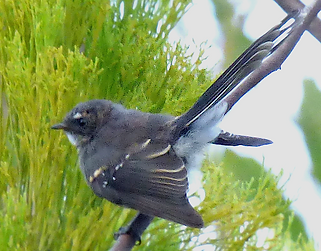
Very common on Knocklofty, this small bird eats insects and is constantly on the move, deftly catching insects in the air and flitting from one branch to another. It has a long tail which it fans out quite often.
A fascinating characteristic of this bird is that it frequently builds more than one nest in a season, and up to seven have been recorded. It is thought that the early nests may be decoys to confuse predators. The 'real' nests tend to be better hidden and more complete. The nest is made of fine grass bound together with large amounts of spider web. The bottom is drawn out into a long stem, a bit like a wine-glass. Both parents build the nest, incubate the eggs and feed the young.
GREY SHRIKE-THRUSH
Colluricincia harmonica

These songbirds are much more easily heard than seen. They are quite nondescript in colour, and both sexes look pretty similar but the female has a streaked throat and breast. They may be confused with olive whistlers and female golden whistlers, but have longer bills and a white eyebrow.
The grey shrike-thrush (AKA "GST") is neither a shrike nor a thrush. The 'thrush' part of the bird's name refers to its beautiful song - it is said to have over a hundred clear, sharp and melodious songs. The 'shrike' part comes from its predatory bill. GSTs have a tendency to raid other bird's nests for eggs and chicks so are often attacked by other birds.
GOLDEN WHISTLER
Pachycephala pectoralis

M
F
Inset: Pixabay
Related to the grey shrike-thrush, this bird is another of Australia's songbirds. The male and female golden whistlers look very different, and the female can easily be confused with a grey shrike-thrush or a female robin. She has a shorter bill than a shrike-thrush and no white eyebrow. She can be distinguished from a robin by her pale throat and lack of distinctive wing markings. The males are very distinctive with a black head, white throat and yellow underside.
Golden Whistlers feed on insects, spiders and other small arthropods, and berries. They mostly pick their food from leaves and bark.
OLIVE WHISTLER
Pachycephala olivacea

Photo: Lindsay Hansch, Canberra Birds
A shy bird which likes to live in thick undergrowth. this bird is not easy to spot and may be more easily located by their call. Some consider this bird to be the most melodious of all the whistlers (although the song has been said to sound like "I'll wet you" or "I'm cranky".)
Olive whistlers eat insects, seeds, berries and leaves. They build their eggs in thick undergrowth and small shrubs.
LAUGHING KOOKABURRA
Dacelo novaeguineae

A striking looking bird, smart and cheeky, the laughing kookaburra is not native to Tasmania and may in fact be a pest here. It's a member of the kingfisher family and eats snakes, frogs and fish amongst other things (it's known for brazenly grabbing the sausage off the barbie). Kookaburras are a cooperative species - they 'laugh' together as an act of solidarity, usually in the face of a competing group.
Kookaburras usually mate for life. They lay up to three eggs, and in around half of cases one of the offspring will kill a sibling. The adult birds do not appear to intervene. On the other hand, adult pairs that have not been able to breed will often adopt orphaned youngsters that still need feeding, which is rare in the animal world.
SATIN FLYCATCHER
Myiagra cyanoleuca
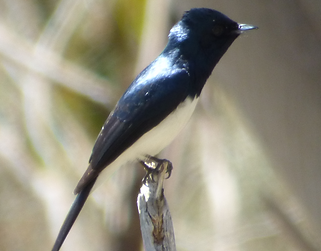
This is a small songbird which is found all the way up the east coast of Australia. The male is glossy blue-black and white, the female has a brown back and orange throat and chest. They have a sleek appearance but may partially lift the head feathers to form a crest. They have a habit of quivering their tails when perched.
They generally live in eucalypt forests, often near watecourses or wetlands. They can be aggressive to other birds and have been known to mob them if they come near to the flycatcher's nest. This helps prevent against predation and potentially parasitism by cuckoos. They migrate north during winter, so numbers are very low in Tasmania over that time. The above was spotted in November 2023.
SILVER EYE
Zosterops lateralis

The silver eye, also called wax eye or white eye, is found around eastern Australia, across the south coast and a large part of the west coast. It's a tiny bird, about 11cm long and weighing around 10g - about as heavy as ten standard paper clips. Despite being so small and light, most Tasmanian silver eyes cross the Bass Strait in their annual migration to warmer states, eating during the day and flying long distances at night. They eat all sorts, from insects and seeds to fruit, nectar and solid fat.
Their nest is a tiny cup of grass, moss, hair, spiderweb, and thistledown, suspended from a branch fork. Eggs hatch after about 11 days and the young birds are able to breed themselves in about nine months.
SUPERB FAIRYWREN
Malurus cyaneus

F
M
A small bird around 14cm long, including a 6cm tail. Females and youngsters are fawn and buff coloured, with an orange patch around the eye and bill. Breeding males display brilliant iridescent blue patches around their head and neck. According to JungleDragon, the colouring may be even more vivid to other fairy wrens as it reflects ultraviolet light strongly, which they can see. In the mating season, males pluck yellow petals and show them to females.
Superb fairywrens live in small social groups of 3-5 birds that roost side by side. The group includes a breeding pair and one or more helper birds that help defend the territory and feed and rear the young. The chicks are fed prey larger than the adults eat themselves. I guess such small birds need to grow as fast as they can.
TREE MARTIN
Petrochelidon nigricans

The tree martin is related to the swallow;
both have glossy blue-black feathers on the crown of the head and back. Tree martins are erratic, darting, agile flyers that eat
insects caught on the wing. They will eat bees, wasps and mosquitoes.
I haven't seen this bird on Knocklofty myself, the photo above was taken at Lake Cethana. In some parts of Australia, these birds will form huge flocks of over 10,000 individuals. They can be found right across Australia in warmer months, but may migrate north as the weather gets cooler.
They are comfortable living in large numbers in city environments. To avoid falcons and hobbies which will kill and eat them, tree martins remain high in the sky until the light begins to fade, then plummet towards the trees in a large group to reach the safety of the leaves as quickly as possible.
WELCOME SWALLOW
Hirundo neoxena

Photo: Wikipedia
A very fast-flying, darting bird, the welcome swallow can be recognised by its metallic blue-black upper parts, rusty coloured face and long forked tail. The bird can live in almost all types of habitat and nest on all sorts of structures from vertical rock walls and hollow trees to boats, caves and mine shafts.
Welcome swallows are said to be good indicators of temperature, they migrate when temperatures get cold and are rarely seen when temperatures drop below -2C.
However, as Aristotle said, "one swallow does not a summer make" (meaning a single event doesn't necessarily indicate a trend).
Welcome swallows need to drink water frequently. Being talented flyers, they can actually drink while flying, scooping water in their bills from the surface of the water body.
WHITE-THROATED NEEDLETAIL
Hirundapus caudacutus

Photo: David Cook, Canberra Birds
Inset: Anthony Overs, Canberra Birds
This bird is named for the needle-like spines that extend beyond the end of its tail, as seen in the photo above. I haven't seen this bird myself - apparently it spends most of its time in the air and can fly pretty high. Its catches insects as it flies and, like the welcome swallow, drinks on the wing.
It's often seen in eastern Australia before storms, low pressure troughs, approaching cold fronts and occasionally bushfire. Termites and ants often swarm in these conditions, providing a good source of food for the bird in the air. Rather than chasing individual insects, the bird dives through swarms catching what it can.
The white-throated needletail is a migratory bird, spending time in Australia between October and April but breeding in Siberia, Mongolia, Northern Japan and the Korean Peninsula.
GOLDFINCH
Carduelis carduelis

Widespread across in Europe, central Asia and northern Africa, the goldfinch was introduced to Australia in the 1860s. It's easily identified by its red, white and black head and the gold bar on its wing. It's song has been described as "a pleasant silvery twittering" which includes the phrase "teLLIT-teLLIT-teLLIT".
It's nest is made of mosses and lichens and lined with plant down such as that from thistles, and attached to the twigs of the tree with spider silk. Wikipedia shows a very soft and cosy looking goldfinch nest - one of the best in the bird world, I reckon. It takes the female a week to complete. A group of goldfinches is called a charm.
Sources
Animal Diversity Web. Acanthorhynchus tenuirostris - eastern spinebill. https://animaldiversity.org/accounts/Acanthorhynchus_tenuirostris/
Animalia. Shining Bronze Cuckoo. https://animalia.bio/shining-bronze-cuckoo
Animalia. Silver Eye. https://animalia.bio/silvereye
Animalia. Superb fairywren. https://animalia.bio/superb-fairywren?taxonomy=1086
Atlas of Living Australia. Carduelis carduelis (Linnaeus, 1758) European Goldfinch.
https://bie.ala.org.au/species/https:/biodiversity.org.au/afd/taxa/07f2e8c3-1e0c-4a02-8177-bf9b54435b93
Australian Government Department of Climate Change, Energy, the Environment and Water. Hirundapus caudacutus — White-throated
Needletail. https://www.environment.gov.au/cgi-bin/sprat/public/publicspecies.pl?taxon_id=682
Australian Government. Department of Climate Change, Energy, the Environment and Water. Myiagra cyanoleuca — Satin Flycatcher.
https://www.environment.gov.au/cgi-bin/sprat/public/publicspecies.pl?taxon_id=612
Australian Museum. Beautiful Firetail. https://australian.museum/learn/animals/birds/beautiful-firetail/
Australian Museum. Black Currawong. https://australian.museum/learn/animals/birds/black-currawong/
Australian Museum. Black-faced Cuckoo-shrike. https://australian.museum/learn/animals/birds/black-faced-cuckoo-shrike/
Australian Museum. Brown Falcon. https://australian.museum/learn/animals/birds/brown-falcon/
Australian Museum. Brown Goshawk. https://australian.museum/learn/animals/birds/brown-goshawk/
Australian Museum. Grey Shrike-Thrush. https://australian.museum/learn/animals/birds/grey-shrike-thrush-colluricincla-harmonica/
Australian Museum. Yellow-rumped thornbill. https://australian.museum/learn/animals/birds/yellow-rumped-thornbill/
Backyard Buddies. New Holland Honeyeater. https://backyardbuddies.org.au/backyard-buddies/new-holland-honeyeater/
Birdlife Australia. Australian Magpie. https://birdlife.org.au/bird-profiles/australian-magpie/#Bird%20Overview
Birdlife Australia. Musk Lorikeet. https://birdlife.org.au/bird-profiles/musk-lorikeet/
Birdlife Australia. Painted Button-quail. https://birdlife.org.au/bird-profiles/painted-button-quail/
Birdlife Australia. Peregrine Falcon. https://birdlife.org.au/bird-profiles/peregrine-falcon/
Birdlife Australia. Pink Robin. https://birdlife.org.au/bird-profiles/pink-robin/
Birdlife Australia. Spotted Dove. https://birdlife.org.au/bird-profiles/spotted-dove/
Birdlife International. Swift Parrot Lathamus discolor. http://datazone.birdlife.org/species/factsheet/swift-parrot-lathamus-discolor
Birds in Backyards. Common bronzewing. https://www.birdsinbackyards.net/species/Phaps-chalcoptera
Birds in Backyards. Fan-tailed cuckoo. https://www.birdsinbackyards.net/species/Cacomantis-flabelliformis
Birds in Backyards. Golden Whistler. https://www.birdsinbackyards.net/species/Pachycephala-pectoralis
Birds in Backyards. Grey fantail. https://www.birdsinbackyards.net/species/Rhipidura-albiscapa
Birds in Backyards. Painted Button-quail. https://www.birdsinbackyards.net/species/Turnix-varius
Birds in Backyards. Southern Boobook. https://www.birdsinbackyards.net/species/Ninox-novaeseelandiae
Birds in Backyards. Spotted Pardalote. https://www.birdsinbackyards.net/species/Pardalotus-punctatus
Birds in Backyards. Striated Pardalote. https://www.birdsinbackyards.net/species/Pardalotus-striatus
Birds in Backyards Forum. Brown goshawk v Collared sparrowhawk. https://www.birdsinbackyards.net/forum/Brown-goshawk-v-Collared-sparrowhawk
Bonorong Wildlife Sanctuary. Birds of Prey Found in Tasmania. https://www.bonorong.com.au/blog/birds-of-prey-found-in-tasmania
Bush Heritage Australia. Tawny Frogmouth. https://www.bushheritage.org.au/species/tawny-frogmouth
Canberra Birds. https://canberrabirds.org.au/
CSIRO. Top 10 most spotted Australian birds. https://www.csiro.au/en/news/All/Articles/2022/October/top-10-australian-birds
DPIPWE Tasmania Wildlife Management Branch. Management of Brown quail in Tasmania. https://nre.tas.gov.au/Documents/Brown-Quail-Brochure.pdf
eBird. Grey shrikethrush. https://ebird.org/species/grysht1?siteLanguage=en_AU
ebird. Dusky robin. https://ebird.org/species/dusrob1?siteLanguage=en_AU
Green Adelaide. Tree Martin. https://www.greenadelaide.sa.gov.au/projects/rewilding-birds-of-prey/awareness-campaign/tree-martin
iNaturalistAU. Australasian Robins. Australasian Robins (Family Petroicidae)
iNaturalistAU. Grey Fantail Rhapidura albiscapa. https://inaturalist.ala.org.au/taxa/144737-Rhipidura-albiscapa
iNaturalistAU. Noisy Miner. https://inaturalist.ala.org.au/taxa/12231-Manorina-melanocephala
iNaturalistAU. Tasmanian Thornbill Acanthiza ewingii. https://www.inaturalist.org/taxa/13465-Acanthiza-ewingii
Jungle Dragon. Grey Currawong – Strepera versicolor. https://www.jungledragon.com/specie/10111/grey_currawong.html
Jungle Dragon. Superb Fairywren. https://www.jungledragon.com/specie/2350/superb_fairywren.html
Kaplan, Gisella (2015). Bird Minds. CSIRO Publishing: Victoria, Australia.
Knowler, D. Tasmania's Endemic Birds. https://donaldknowler.com/endemic-bird-essays/
Life in the Suburbs. Pachycephala olivacea. http://keyserver.lucidcentral.org/key-server/data/03050501-000c-4503-8203-0a030507090d/media/Html/Pachycephala_olivacea.htm
McNab, A. (2018). The Guide to Tasmanian Wildlife. Forty South Publishing Pty Ltd
Museums Victoria. Phylidonyris novaehollandiae, New Holland Honeyeater. https://collections.museumsvictoria.com.au/species/
New Zealand Birds Online. Eastern Rosella | Kākā uhi whero. https://nzbirdsonline.org.nz/species/eastern-rosella
NSW Office of the Environment and Heritage. White-throated Needletail – profile.
https://www.environment.nsw.gov.au/threatenedspeciesapp/profile.aspx?id=20354
NSW Office of Environment and Heritage. Swift Parrot - profile
https://www.environment.nsw.gov.au/threatenedspeciesapp/profile.aspx?id=10455
Psittacology. Green Rosella | Platycercus caledonicus Care & Info. https://www.psittacology.com/green-rosella-care/
South Australian Department for Environment and Heritage. Brush bronzewing Phaps elegans.
https://cdn.environment.sa.gov.au/landscape/docs/hf/pa-fact-brushbronzewing.pdf
South Australian Department for Environment and Heritage. Petroica boodang boodang – Scarlet Robin.
https://cdn.environment.sa.gov.au/landscape/docs/hf/pa-fact-scarletrobin.pdf
State Wide Integrated Flora and Fauna Teams. Grey Goshawk. https://www.swifft.net.au/cb_pages/sp_grey_goshawk.php
The Bribie Islander. Bribie Island Wildlife – Grey Shrike-Thrush Colluricincla Harmonica
The Secret Life of our Urban Birds. Television series, ABC iView. https://iview.abc.net.au/show/secret-lives-of-our-urban-birds/series/1/video/SC2203H001S00
Threatened Species Link. Species Management Profile Accipiter novaehollandiae. Grey Goshawk.
https://www.threatenedspecieslink.tas.gov.au/Pages/Grey-Goshawk.aspx
Threatened Species Link. Species Management Profile: Lathamus discolor Swift Parrot. https://www.threatenedspecieslink.tas.gov.au/Pages/Swift-Parrot.aspx
Wikipedia. Brush Bronzewing. https://en.wikipedia.org/wiki/Brush_bronzewing
Wikipedia. Little Wattlebird. https://en.wikipedia.org/wiki/Little_wattlebird
Wikipedia. Horsfield's bronze cuckoo. https://en.wikipedia.org/wiki/Horsfield%27s_bronze_cuckoo
Wikipedia. Pallid cuckoo.
https://en.wikipedia.org/wiki/Pallid_cuckoo#:~:text=The%20pallid%20cuckoo%20is%20widely,September%20or%20October%2C%20sometimes%20earlier.
Wikipedia. Peregrine falcon. https://en.wikipedia.org/wiki/Peregrine_falcon
Wikipedia. Sulphur-crested cockatoo. https://en.wikipedia.org/wiki/Sulphur-crested_cockatoo
Wikiepedia. Tasmanian Boobook. https://en.wikipedia.org/wiki/Tasmanian_boobook
Wikipedia. Tiny birds cry wolf to scare predators. https://en.wikipedia.org/wiki/File:Tiny_birds_cry_wolf_to_scare_predators.webm
Wikipedia. Welcome Swallow. https://en.wikipedia.org/wiki/Welcome_swallow
Wikipedia. Yellow-tailed black cockatoo. https://en.wikipedia.org/wiki/Yellow-tailed_black_cockatoo
World Parrot Trust. Sulphur-Crested Cockatoo (Cacatua galerita). https://www.parrots.org/encyclopedia/sulphur-crested-cockatoo